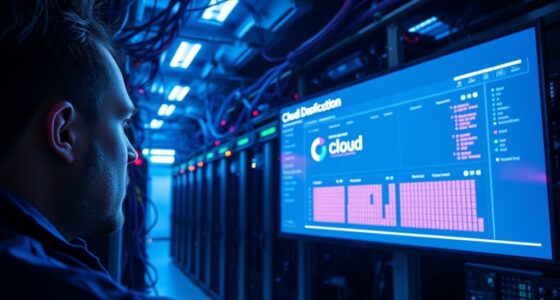SaaS Security Posture Management is your key to proactively safeguarding data, ensuring compliance, and staying ahead of evolving cyber threats. By continuously evaluating risks, monitoring activity, and leveraging AI-driven solutions, you can quickly identify vulnerabilities, misconfigurations, and suspicious behavior. Establishing an all-encompassing security strategy helps reduce legal and reputational risks while strengthening defenses. To learn how to build an effective approach that keeps your SaaS environment secure, keep exploring this essential frontier.
Key Takeaways
- SaaS Security Posture Management (SSPM) offers continuous oversight to ensure compliance and security in dynamic cloud environments.
- It leverages AI-driven tools for real-time threat detection and proactive risk mitigation.
- SSPM enhances visibility into user activity, data access, and system configurations, enabling rapid anomaly detection.
- Implementing SSPM supports a proactive security strategy by integrating risk assessments, monitoring, and incident response.
- Adopting SSPM reduces legal and reputational risks by maintaining adherence to industry standards and regulations.

Have you ever wondered how to effectively monitor and improve your SaaS security? In today’s digital landscape, SaaS security posture management (SSPM) becomes essential to protect your organization from evolving threats. One of the first steps is understanding the importance of cloud compliance. Cloud compliance isn’t just a checkbox; it’s a critical process that ensures your SaaS applications adhere to industry standards and regulations. Achieving compliance requires continuous oversight, so you can identify gaps and implement necessary controls swiftly. By aligning your SaaS security with compliance frameworks, you reduce exposure to legal penalties and reputational damage, while also establishing a foundation for robust security practices.
Effective SaaS security starts with understanding cloud compliance and continuous oversight to protect your organization from evolving threats.
Alongside cloud compliance, risk assessment plays a key role in SaaS security. You need to continuously evaluate the risks associated with your SaaS environment—know what vulnerabilities exist, how significant they are, and what potential threats could exploit them. Risk assessment isn’t a one-time activity; it’s an ongoing process that involves scanning for misconfigurations, weak access controls, and insecure integrations. This proactive approach enables you to prioritize remediation efforts where they’re needed most, preventing breaches before they occur. When combined, cloud compliance and risk assessment give you a clearer picture of your security posture, making it easier to implement targeted, effective controls. Incorporating AI-driven cybersecurity solutions can further enhance your ability to identify emerging threats in real-time, ensuring your defenses stay ahead of malicious actors.
Monitoring your SaaS environment in real-time is equally important. You should leverage security tools that provide visibility into user activity, data access, and system changes. This ongoing monitoring helps you spot anomalies early—like unusual login attempts or data transfers—that could indicate malicious activity. Automated alerts and dashboards keep you informed, so you can respond swiftly to potential threats. In addition, regular audits and reviews of your SaaS security policies ensure your controls stay aligned with evolving threats and compliance requirements. This full-circle approach not only minimizes risk but also builds resilience against cyberattacks.
Implementing a comprehensive SaaS security posture management strategy might seem overwhelming at first, but focusing on these core areas makes it manageable. Start with understanding your compliance obligations and conduct regular risk assessments to identify vulnerabilities. Use continuous monitoring tools to keep an eye on your environment, and establish clear protocols for incident response. By doing so, you’ll create a security culture that’s proactive rather than reactive. Ultimately, mastering SaaS security posture management means staying ahead of threats, maintaining compliance, and safeguarding your organization’s data and reputation in an increasingly complex digital world.
Frequently Asked Questions
How Does SSPM Integrate With Existing Security Tools?
SSPM integrates seamlessly with your existing security tools through robust APIs and pre-built connectors, enabling smooth tool integration. This integration helps you gain a thorough view of your security posture and streamlines risk mitigation efforts. By connecting SSPM with your SIEM, CASB, or identity management solutions, you can automate alerts, enhance collaboration, and strengthen your overall security strategy, making your defenses more resilient and proactive.
What Are the Key Metrics to Measure SSPM Effectiveness?
You want to measure SSPM effectiveness, so focus on key metrics like risk metrics and performance indicators. Track how well your security controls reduce vulnerabilities, monitor compliance scores, and assess the response time to threats. These metrics help you understand your security posture, identify gaps, and improve your SSPM strategies. Regularly reviewing these indicators guarantees your SaaS environment stays protected and aligned with your organization’s security goals.
How Often Should Saas Security Assessments Be Conducted?
You should conduct SaaS security assessments regularly, ideally aligning with your security review cadence. For most organizations, an assessment frequency of quarterly or bi-annual reviews works best to catch vulnerabilities early and adapt to evolving threats. This consistent approach ensures your SaaS environment stays secure and compliant. Adjust the assessment frequency based on your organization’s size, risk level, and changes in your SaaS landscape to maintain ideal security posture.
Can SSPM Prevent Zero-Day Saas Vulnerabilities?
You might wonder if SSPM can prevent zero-day SaaS vulnerabilities. While SSPM tools excel at threat mitigation and provide zero-day detection by monitoring for unusual activity, they can’t fully prevent zero-day exploits. Instead, they help you identify and respond quickly to emerging threats, reducing potential damage. Staying vigilant and combining SSPM with other security measures enhances your defenses against these unpredictable vulnerabilities.
What Are the Compliance Considerations for SSPM Deployment?
When deploying SSPM, you need to take into account compliance with regulatory frameworks like GDPR or HIPAA, which dictate data privacy standards. Make sure your SSPM tools align with these regulations, safeguarding sensitive data and maintaining audit trails. You should also verify that your deployment supports ongoing compliance monitoring, addressing potential vulnerabilities proactively. Staying informed about evolving regulations helps you avoid penalties and protects your organization’s reputation while securing your SaaS environment effectively.
Conclusion
As you navigate the evolving landscape of SaaS security, embracing Security Posture Management is your compass through a maze of threats. It’s not just a tool, but your shield, guiding you to proactively identify and fix vulnerabilities. Remember, neglecting this frontier leaves your defenses as fragile as glass—beautiful but easily shattered. Stay vigilant, adapt continuously, and let SaaS security posture management be the sturdy anchor that keeps your organization afloat amid rising cyber tides.









